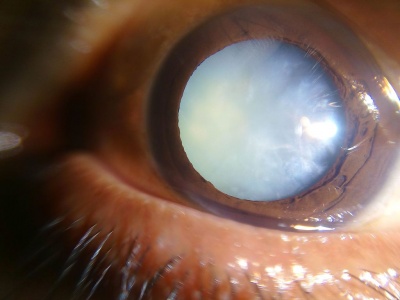Cataracts: Difference between revisions
No edit summary |
No edit summary |
||
| Line 6: | Line 6: | ||
==Clinical Features== | ==Clinical Features== | ||
[[File:Dense white mature cataract.jpg|thumb|right|The appearance of a dense, white cataract in a 60 year-old male. ]] | |||
=== History === | === History === | ||
* Cloudy or blurry vision | * Cloudy or blurry vision | ||
| Line 16: | Line 17: | ||
* Darkening of the red reflex | * Darkening of the red reflex | ||
* Decreased visual acuity | * Decreased visual acuity | ||
==Differential Diagnosis== | ==Differential Diagnosis== | ||
Revision as of 18:11, 16 December 2020
Background
- A cataract is opacification in the lens of one or both eyes which can lead to decreased visual acuity and visual distortions
- Cataracts are most commonly due to normal age related changes, however they can also be caused by eye trauma, exposure to sunlight or radiation, malnutrition, corticosteroid use, and other pathologic processes
- By age 80 approximately 50% of Americans have been diagnosed with one or more cataracts[1]
- Additional risk factors for cataract include Diabetes, smoking, prolonged exposure to sunlight, and alcohol use[1][2]
Clinical Features
History
- Cloudy or blurry vision
- Difficulty with night time vision
- Colors appear faded
- Appearance of a halo around bright lights
- Recent trauma to the eye
Exam Findings
- Lens opacity on ophthalmic examination
- Darkening of the red reflex
- Decreased visual acuity
Differential Diagnosis
Evaluation
Workup
Diagnosis
Management
Disposition
See Also
External Links
https://www.nei.nih.gov/learn-about-eye-health/eye-conditions-and-diseases/cataracts
References
[1] National Eye Institute, "Cataracts." https://www.nei.nih.gov/learn-about-eye-health/eye-conditions-and-diseases/cataracts [2] West SK, and Valmadrid CT, "Epidemiology of risk factors for age-related cataract," Surv Ophthalmol. 1995;39(4):323.




